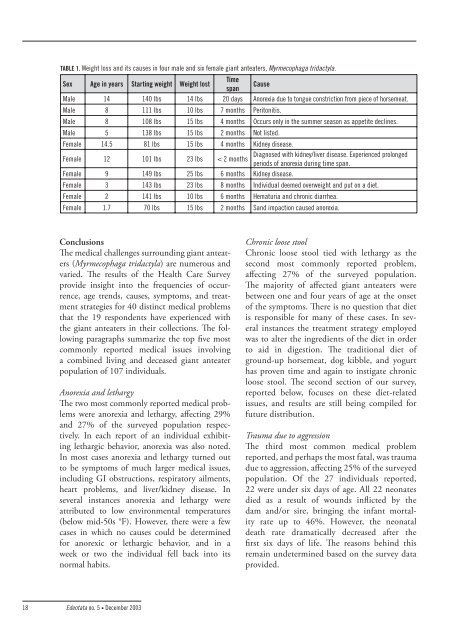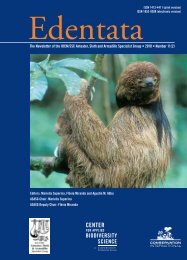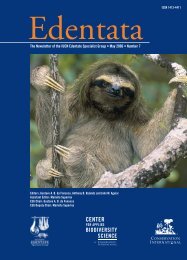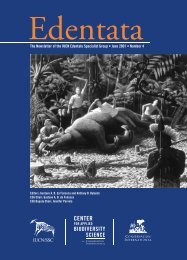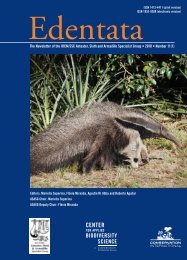TABLE 1. Weight loss and its causes in four male and six female giant anteaters, Myrmecophaga tridactyla.Sex Age in years Starting weight Weight lostTimespanCauseMale 14 140 lbs 14 lbs 20 days Anorexia due to tongue constriction from piece of horsemeat.Male 8 111 lbs 10 lbs 7 months Peritonitis.Male 8 108 lbs 15 lbs 4 months Occurs only in the summer season as appetite declines.Male 5 138 lbs 15 lbs 2 months Not listed.Female 14.5 81 lbs 15 lbs 4 months Kidney disease.Female 12 101 lbs 23 lbs < 2 monthsDiagnosed with kidney/liver disease. Experienced prolongedperiods of anorexia during time span.Female 9 149 lbs 25 lbs 6 months Kidney disease.Female 3 143 lbs 23 lbs 8 months Individual deemed overweight and put on a diet.Female 2 141 lbs 10 lbs 6 months Hematuria and chronic diarrhea.Female 1.7 70 lbs 15 lbs 2 months Sand impaction caused anorexia.Conclusionse medical challenges surrounding giant anteaters(Myrmecophaga tridactyla) are numerous andvaried. e results of the Health Care Surveyprovide insight into the frequencies of occurrence,age trends, causes, symptoms, and treatmentstrategies for 40 distinct medical problemsthat the 19 respondents have experienced withthe giant anteaters in their collections. e followingparagraphs summarize the top five mostcommonly reported medical issues involvinga combined living and deceased giant anteaterpopulation of 107 individuals.Anorexia and lethargye two most commonly reported medical problemswere anorexia and lethargy, affecting 29%and 27% of the surveyed population respectively.In each report of an individual exhibitinglethargic behavior, anorexia was also noted.In most cases anorexia and lethargy turned outto be symptoms of much larger medical issues,including GI obstructions, respiratory ailments,heart problems, and liver/kidney disease. Inseveral instances anorexia and lethargy wereattributed to low environmental temperatures(below mid-50s °F). However, there were a fewcases in which no causes could be determinedfor anorexic or lethargic behavior, and in aweek or two the individual fell back into itsnormal habits.Chronic loose stoolChronic loose stool tied with lethargy as thesecond most commonly reported problem,affecting 27% of the surveyed population.e majority of affected giant anteaters werebetween one and four years of age at the onsetof the symptoms. ere is no question that dietis responsible for many of these cases. In severalinstances the treatment strategy employedwas to alter the ingredients of the diet in orderto aid in digestion. e traditional diet ofground-up horsemeat, dog kibble, and yogurthas proven time and again to instigate chronicloose stool. e second section of our survey,reported below, focuses on these diet-relatedissues, and results are still being compiled forfuture distribution.Trauma due to aggressione third most common medical problemreported, and perhaps the most fatal, was traumadue to aggression, affecting 25% of the surveyedpopulation. Of the 27 individuals reported,22 were under six days of age. All 22 neonatesdied as a result of wounds inflicted by thedam and/or sire, bringing the infant mortalityrate up to 46%. However, the neonataldeath rate dramatically decreased after thefirst six days of life. e reasons behind thisremain undetermined based on the survey dataprovided.18 <strong>Edentata</strong> no. 5 • December 2003
Respiratory ailmentse fourth most commonly reported medicalproblem consisted of respiratory ailments includingpneumonia, upper respiratory congestion,and nasal discharge. Generally these ailmentsseemed to predominantly affect female individualsunder the age of two years. e majorityof reported causes centered on the cold/wetenvironments some of these giant anteaters wereexposed to. In the cases where temperatures werereported, the definition of cold was considered tobe below the mid-50s °F. In the situations wherepneumonia developed, the fatality rate was nearly60%. Practically all the respondents that haddealt with these respiratory ailments agreed thatproviding a warm (> 70 °F) and dry environmentwas important in preventing the onset of respiratory-relatedproblems.Vitamin K deficiencye fifth most frequently reported medicalproblem experienced by the giant anteaterwas vitamin K deficiency, affecting 18% of the107 individuals surveyed. e spontaneousbleeding from the rectum, genitalia, and/ornose caused by this deficiency was generallydue to a nutritionally incomplete diet. Alteringthe dietary components to include Leaf-Eaterbiscuits high in vitamin K was one solution frequentlyemployed. e alternative used by severalfacilities was to add vitamin K supplements tothe nutritionally incomplete diet.After sorting through all the medical recordsprovided by the 19 respondents, a pattern beganto emerge. ose institutions that weighed theiranteaters on a regular basis (i.e., at least once permonth) appeared to have greater success recognizingany potential medical problems earlier on.Because anorexia is such a prevalent symptomin so many medical problems anteaters experience,weight loss usually occurs as a result. Beingable to recognize this is key, especially for thoseinstitutions that do not monitor dietary intakeof individual anteaters. Just from a visual inspection,it is difficult to accurately judge whetheror not an anteater has lost weight, because itsbody hair and robust ribcage can mask weightloss easily. Anorexia, weight loss, and lethargy arethree symptoms that we as anteater caretakers caneasily observe and monitor. When we see themoccur in unison, this should serve as a red flagindicating that closer scrutiny is required in orderto determine if a medical problem is arising or ifit is nothing at all.AcknowledgementsWe sincerely thank the 19 institutions that participatedin the Health Care Section of the giantanteater survey. ose institutions include: ReidPark Zoo (Tucson, Arizona); Chaffee ZoologicalGardens (Fresno, California); San FranciscoZoological Gardens (San Francisco, California);Santa Barbara Zoological Gardens (Santa Barbara,California); Jacksonville Zoological Gardens(Jacksonville, Florida); Disney’s AnimalKingdom (Lake Buena Vista, Florida); BrevardZoo (Melbourne, Florida); Brookfield ZoologicalPark (Brookfield, Illinois); Rolling Hills RefugeWildlife Conservation Center (Salina, Kansas);Audubon Park Zoological Gardens (NewOrleans, Louisiana); Detroit Zoological Institute(Detroit, Michigan); Cleveland Metroparks Zoo(Cleveland, Ohio); Columbus Zoological Gardens(Columbus, Ohio); Oklahoma City ZoologicalGardens (Oklahoma City, Oklahoma);Philadelphia Zoological Gardens (Philadelphia,Pennsylvania); Nashville Zoo (Nashville, Tennessee);Houston Zoological Gardens (Houston,Texas); Caldwell Zoo (Tyler, Texas); and LondonZoo (London, England).e information provided by these facilities hasshed some light on the basic trends in medicalproblems experienced by giant anteaters incaptivity. In conjunction with these illnesses, wehave also gained valuable insight into the treatmentstrategies employed by the respondents intheir attempts to provide the best care possibleto the giant anteaters in their collection. We areespecially grateful to Mike Flint, the GeneralCurator and Giant <strong>Anteater</strong> Studbook Keeperat Reid Park Zoo. Mike’s interest and supportregarding this survey has helped immenselyin encouraging others to participate and shareinformation about the giant anteaters in their19
- Page 1 and 2: EdentataThe Newsletter of the IUCN
- Page 3 and 4: ARTICLESA Localidade Tipo da Pregui
- Page 5 and 6: quetas originais que acompanhavam o
- Page 7 and 8: Tolypeutes tricinctus (Linnaeus, 17
- Page 9: Figure 2 displays of all the known
- Page 12 and 13: FIGURE 5B. Medical Problems, contin
- Page 14 and 15: Eater is high in cellulose, which m
- Page 16 and 17: Symptoms: Loss of appetite - depend
- Page 18 and 19: eported. Low environmental temperat
- Page 22 and 23: collections. Lastly, we want to ack
- Page 24 and 25: FIGURE 3. Dietary supplements used.
- Page 28 and 29: FIGURA 1. Incremento de peso de Jun
- Page 30 and 31: comparar sus medidas y pesos con un
- Page 32 and 33: Em ambos os locais, há poucos cupi
- Page 34 and 35: TABELA 2. Espécies de formigas for
- Page 36 and 37: L. R. Leite (eds.), pp.33-40. Funda
- Page 38 and 39: actividad. No fue posible realizar
- Page 40 and 41: of attaching a transmitter to an an
- Page 42 and 43: Authority (Coordenação de Aperfei
- Page 44 and 45: Automatic CamTrakker phototrap phot
- Page 46 and 47: ReferencesEisenberg, J. F. and Redf
- Page 48 and 49: Montgomery, G. G. 1985b. Movements,
- Page 50 and 51: noviembre y diciembre. Se estima qu
- Page 52 and 53: TABLA 1. Medidas biométricas y pes
- Page 54 and 55: a que esta especie después del apa
- Page 56 and 57: • Los párpados pueden ser abiert
- Page 58 and 59: Official List of Brazilian Fauna Th
- Page 60 and 61: most severe for armadillos, which a
- Page 62 and 63: addition, Izoceño hunters have pro
- Page 64 and 65: and support for conservation effort
- Page 66 and 67: since 1992. Unfortunately, that stu
- Page 68 and 69: the first step in developing a rese
- Page 70 and 71:
available on the Roger Williams Par
- Page 72 and 73:
See for more details. From:IUCN Sp
- Page 74 and 75:
tion. e IUCN 2000 criteria are used
- Page 76 and 77:
Diversidad y Conservación de los M
- Page 78 and 79:
techniques used for the preparation
- Page 80 and 81:
Corredor Central da Mata Atlântica
- Page 82 and 83:
McDonald, H. G. 2002. Fossil Xenart
- Page 84:
or contact SherylFink at .Associati
- Page 87 and 88:
NOTES TO CONTRIBUTORSScopeEdentata,


